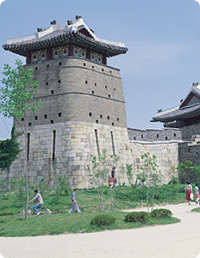Fortress
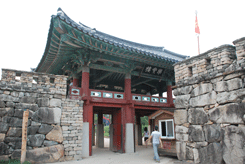 |
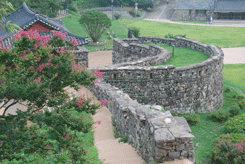 |
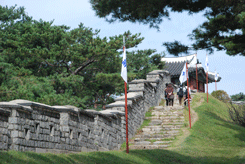 |
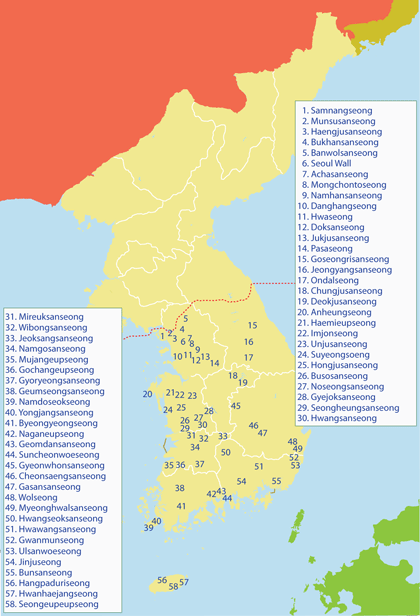 Seoul city wall
Seoul city wall 18.2km-long city wall was hastily built in 1396 which crept over Namsan, up the east and west sides of the valley and turn up to the top of the Bukaksan Mountain. The wall was about 6m thick at the base and stood between 3m and 6m high. The wall was built in 98 sections of 600 paces each. Each section was given a label according to the order of the first 98 characters of the Chinese classical primer. The Wall of Seoul connects Bukaksan (342m), Naksan (125m), Namsan 262m) and Inwangsan (338m). The first construction took place for 49 days during January and February in 1396, and 118,000 men were mobilized for the project. Again, in August and September, which was the agricultural off-season of fall, 79,400 men were mobilized for 49 days to complete wall, which had not been completed in spring that year, as well as construction of four main gates and four small gates at the same time. There were all nine gates (Heunginjimun - East Gate, Donuimun - West Gate, Sungyemun - South Gate, Sukjeongmun - North Gate, four small gates; Gwanghimun, Souimun, Changuimun, Hyehwamun, and Ogansumun with its five sluices at its base) built into the wall. Extensive repairs were undertaken in 1422. Later in 1899, some parts of the wall were demolished for tram lines. During the Japanese colonial rule, the walls and gates were demolished by their urban planning. In the 70s, the walls were restored at a considerable length.
Suwon Hwaseong
It was built in 1794-1796 during the reign of King Jeongjo, the 22nd ruler of the Joseon dynasty (1392-1910). Though it is relatively small in scale, Hwaseong has been recognized by experts as the best structure of its kind built ever built. The four gates of Paldal, Jangan, Hwaseo, and Changnyongstand stand majestically at four directions. The fortress has a total perimeter of 5.74Km and encloses an area of 1.3㎢. It encloses both flatland and hilly terrain with well over 30 buildings including gates, watchtowers, command posts, arrow-launchers, fire bastions and beacon towers. The fortress has multifunctional design as a military, political, and commercial center, making it very unique indeed. Of the most frequented points are Seobuk Gongsimdon watch tower for its architectural beauty, Hwahongmun gate with its half-gabled and half-hipped roof and seven sluices at its base, beacon tower, Soejangdae, the commander post set on the highest point of the whole fortress. The fortress is now listed as a UNESCO World Heritage.
Namhansanseong
Located about 30 Km southeast of Seoul, Namhansansong is a walled fortress where Joseon King Injo took refuge during a Manchu invasion in 1637. But, after 45 days of fighting with his 17,000 troops, he surrendered here. The 8km-long fortress, which actually dates to the Three Kingdoms period, had been greatly renovated from 1624 in anticipation of another invasion. The wall had numerous facilities including twelve gates, four command posts, a palace, a variety of office buildings, several shrines and seven temples. The existing facilities include four gates, a training center, two shrines, the Changgyeongsa temple, and a two-story defense command lookout.
Bukansanseong
Built by Baekche King Kaeru (reign: 128-166) to protect the area from Goguryeo. After Goguryeo had expelled Baekje, King Jangsu (413-491) took the fortress to guard the region. It is about 9km long with a height range from 1m on higher mountains to 5.4m on level stretches. The wall encloses seven parks and several temples. A palace with eight gates was built inside the fortress and was kept stocked with rice in case the court should need it in time of crisis. Today, many hiking trails are leading up to the walls.
Gangwha fortress
Ganghado is an island located about 56km northwest of Seoul. Some of the best preserved fortresses are on this island. The island's eastern shore is dotted with fortresses. The first construction was made in the thirteenth century by Goryeo King Gojong, and rebuilt in the Joseon period. In the late nineteenth century, Korea opened its door to the world after French, American and Japanese naval expeditions to this island.
Hengjusanseong
The fortress is believed to have been first constructed during the Baekje Kingdom based upon pieces of tiles and earthenware excavated from the site. Built atop Mt. Dokyangsan (124 meter) about 25km northwest of Seoul is Hengjusansong. It was the site of one of the fiercest battles against Japanese troops. The worst fighting began at six in the morning on February 12, 1593, when 30,000 Japanese troops led by Konishi attacked the fortress. Japanese attacks continued nine times from three sides of this small hill. General Kwon Yul successfully defended the fortress with his 10,000 men. In the shrine houses the portrait of the general. During the fierce offensive and defensive battle that was waged on the sides of the mountain, Korean women played a key role by carrying small rocks with their large white aprons to soldiers who were running short of weapons such as arrows and rifles. Risking their lives in the heat of the battle, these brave women helped turn the tide of the battle. From that time on the fortress was called "Haengjusansong", meaning the apron fortress. A monument a top Mt. Dokyangsan is a reminder of the victory. Nearby is the monumental stele erected in 1603. While you are up there on the top of the mountain check out the Chunguijong Pavilion. This visual education center features a 17-minute film about the battle and the history of Haengjusansong. There is also a small museum just down from the top of the mountain which houses replicas of the weapons used during the battle and even a copy of the type of apron used by the women to carry stones to the soldiers.
Gongsanseong Fortress
Korean castles and fortresses embody the turbulent history of Korea that has suffered almost 900 invasions. The countryside is punctuated by several of them, most of which are in ruins now. Gongsanseong is located in Gongju that served at one time as the Baekje (BC18-AD660) capital for 64 years. The rectangular shaped 2,660m-long fortress stretches 800m from east to west and 400m from north to south. Gongsanseong was constructed to protect the people against foreign invasions. The fortress embodies historical and cultural richness and is a fine example of a mountain castle of the Baekje period. Originally called Ungjinseong, the mud fortress was used by King Munju (475-477 A.D.). In 538 A.D., however, King Seong moved the capital to present-day Buyeo, although Gongju remained fairly important until the Baekje Dynasty collapsed in 660 A.D. The fortress was rebuilt with stones during the Joseon Dynasty, and King Injo hid here to avoid the riot by Yi Gwal in 1623 for a short time as well. Remains in the fortress include royal palace sites, two ponds, gates and towers. Winding out the sights is Yeongeunsa, a temple originally built in 1458. The temple's claim to fame -The lecture hall was used as living space for monks fighting during the 1592 Hideyoshi invasion. A temple probably existed before that, since six Buddha statues were found from the United Silla period (668 - 935 A.D.), but little is known on where they're displayed today.
Ondal fortress
It used to be the most southern outpost of the ancient Goguryeo Kingdom (BC37-AD668). For a long period it was the site of fierce battles between Goguryeo and Silla, another Korean kingdom situated at the south of the Peninsula. Although 15 centuries have passed, traces of battles can still be seen on the walls of the fortress, further evidence of continuous wars. The fortress itself is built on top of a mountain and stands in a very important place from a military point of view. Thanks to its elevated position, the breathtaking view of the neighborhood with the Namhan River, mountains and a valley opens as soon as you reach the Ondal fortress. It is probably the best-preserved Goguryeo fortress on the territory of South Korea. The total length of walls is almost 700 meters.
Gyejok sanseong
It is located in the north of Daejon. It is believed to have been built here when Baekje moved its capital to Buyeo in the 6th century. The fortress was built in the strategically important location. Here several battles were fought against Shilla forces. It is the largest one among about 30 Baekje fortresses in the region. Building sites including watch tower and well site of diameter of 1.9m were excavated. A number of roof tiles and earthen wares of Baekje, Goryeo and Joseon style were found.
Jinjuseong
The fortress was first constructed in 1354 during the Goryeo period. The fortress on a cliff overlooking the river meandering Jinju city is the site of a victory over Japanese invaders in the sixteenth century. Jinju is a home of a patriotic Nonke, who plunged herself into the river with hugging a Japanese general who captured the fortress. There are several temples, shrines and pavilions within the fortress. Of particular note is the Choksoknu pavilion and Uiam, an inscribed rock that marks the spot where Nonke jumped into the river.
Nagan fortress
It was built into a mud rampart in the 14th century to block the Japanese troops. Later in the 16th century, the fortress was reinforced with stones, subsequently became the castle. Unlike other fortresses, Nagan fortress is situated on a wide plain. It was built on naturally square stones, varying in size from one to two meters. The total length of the 4m-high fortress wall is 1,410m. 180 traditional thatched roof houses are still functioning. Among the attractions of the village are monument of Admiral Im Gyongup and local marketplace.
Hangpaduri
Located on the Jeju Island, the fortress, unlike other fortresses, was constructed as double walls, inner castle of stone and outer one with soil. The fortress was built by Sambyolcho troops or the three elite patrols in 1271, who resisted the court's peace treaty with the Yuan. The general Kim Tongjung fled to Jeju after his defeat in the Wando Island. In the fortress were built with a palace, four gates, offices, watch towers, barracks and arsenal, but today, only remains a part of soil wall. All of the Sambyolcho's resistance ended in 1273 when 10,000 Goryeo court troops in 160 ships arrived in Jeju. Jeju is an hour flight from Seoul. The wall is 10km west of the Jeju city.
Ulsan Waeseong
This fort was designed and built by a Japanese general, Kiyomasa Kato in 1597 during the war between Korea and Japan. About 16,000 Japanese soldiers were called out to build it in about 40 days, out of stones from barracks of Ulsan and Byeongyeong. A main fortress is built in the south of the top of the mountain, the second fortress in the lower north of the main fortress, and the third one further down to the west and north of the second. The wall has a total length of 1,300 meters and a height of 10~15 meters. The fortress was double structured by installing a wooden fence of 2,400 meters outside the fortress. The allied army of Korea and Ming China attacked over two times in December, 1597 and September, 1598, and finally Japanese soldiers escaped after setting the fort on fire in November, 1598, following an order of retreat after the commander. Toyotomi Hideyoshi died and the 7 year-war ended in 1598.
Gwanmunseong
This fortress was built in 722 to protect the Shilla capital of Gyeongju from Japanese invaders. The fortress is composed of 40-50Cm length stones, piled in the running bond method of wall construction wider at the base and narrowing gradually to reach a height of 5 or 6 stone-stages (4-5 meters). The wall starts at the southern end of the Chisullyeong range 765 meters, above seas level and follows the border between the provinces of Gyeongsanbbuk-do and Ulsan till it reaches the eastern end at Mowhari. The total length of the wall is 12km.





